Chaoqun Wang
Fellow, IEEE
Estimated Informed Anytime Search for Sampling-Based Planning via Adaptive Sampler
Aug 29, 2025Abstract:Path planning in robotics often involves solving continuously valued, high-dimensional problems. Popular informed approaches include graph-based searches, such as A*, and sampling-based methods, such as Informed RRT*, which utilize informed set and anytime strategies to expedite path optimization incrementally. Informed sampling-based planners define informed sets as subsets of the problem domain based on the current best solution cost. However, when no solution is found, these planners re-sample and explore the entire configuration space, which is time-consuming and computationally expensive. This article introduces Multi-Informed Trees (MIT*), a novel planner that constructs estimated informed sets based on prior admissible solution costs before finding the initial solution, thereby accelerating the initial convergence rate. Moreover, MIT* employs an adaptive sampler that dynamically adjusts the sampling strategy based on the exploration process. Furthermore, MIT* utilizes length-related adaptive sparse collision checks to guide lazy reverse search. These features enhance path cost efficiency and computation times while ensuring high success rates in confined scenarios. Through a series of simulations and real-world experiments, it is confirmed that MIT* outperforms existing single-query, sampling-based planners for problems in R^4 to R^16 and has been successfully applied to real-world robot manipulation tasks. A video showcasing our experimental results is available at: https://youtu.be/30RsBIdexTU
Genetic Informed Trees (GIT*): Path Planning via Reinforced Genetic Programming Heuristics
Aug 28, 2025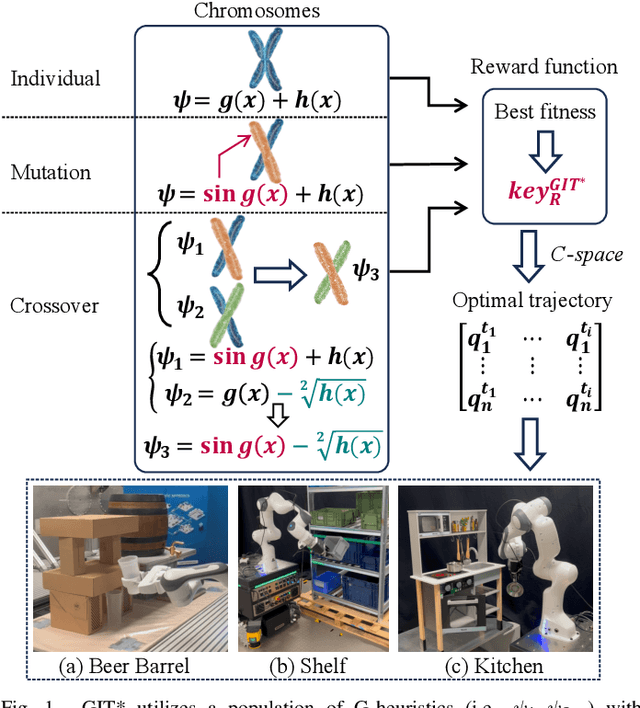
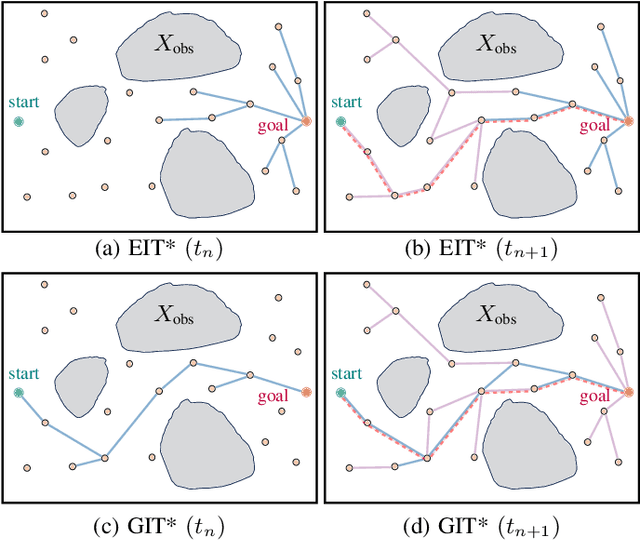
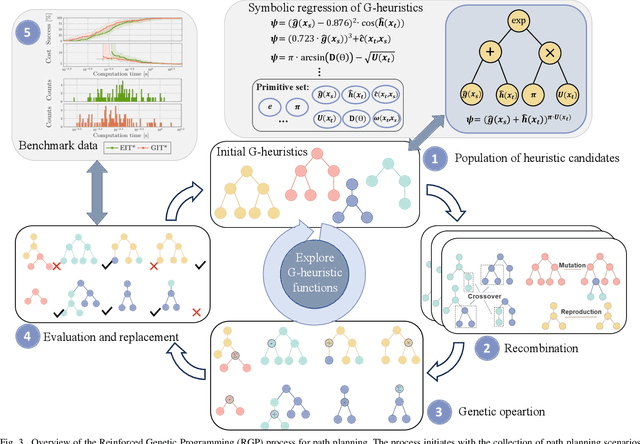
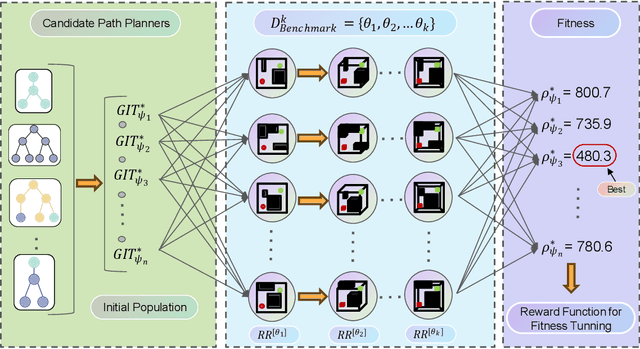
Abstract:Optimal path planning involves finding a feasible state sequence between a start and a goal that optimizes an objective. This process relies on heuristic functions to guide the search direction. While a robust function can improve search efficiency and solution quality, current methods often overlook available environmental data and simplify the function structure due to the complexity of information relationships. This study introduces Genetic Informed Trees (GIT*), which improves upon Effort Informed Trees (EIT*) by integrating a wider array of environmental data, such as repulsive forces from obstacles and the dynamic importance of vertices, to refine heuristic functions for better guidance. Furthermore, we integrated reinforced genetic programming (RGP), which combines genetic programming with reward system feedback to mutate genotype-generative heuristic functions for GIT*. RGP leverages a multitude of data types, thereby improving computational efficiency and solution quality within a set timeframe. Comparative analyses demonstrate that GIT* surpasses existing single-query, sampling-based planners in problems ranging from R^4 to R^16 and was tested on a real-world mobile manipulation task. A video showcasing our experimental results is available at https://youtu.be/URjXbc_BiYg
APT*: Asymptotically Optimal Motion Planning via Adaptively Prolated Elliptical R-Nearest Neighbors
Aug 27, 2025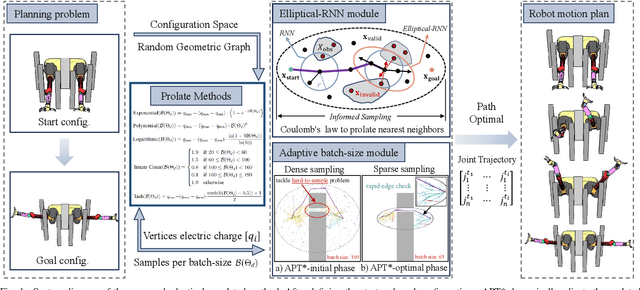
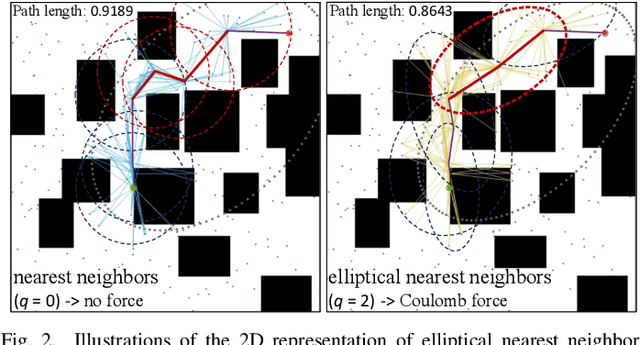
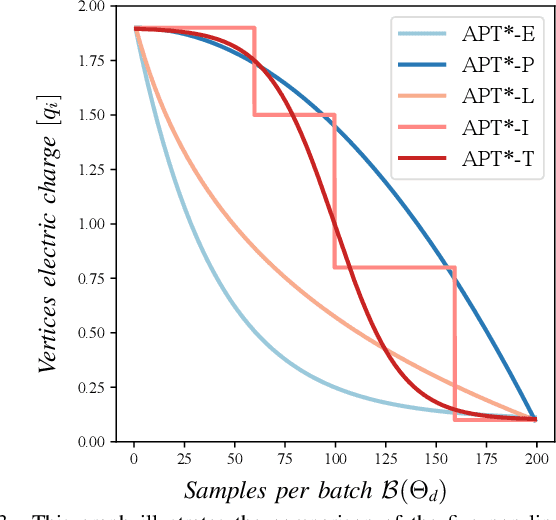

Abstract:Optimal path planning aims to determine a sequence of states from a start to a goal while accounting for planning objectives. Popular methods often integrate fixed batch sizes and neglect information on obstacles, which is not problem-specific. This study introduces Adaptively Prolated Trees (APT*), a novel sampling-based motion planner that extends based on Force Direction Informed Trees (FDIT*), integrating adaptive batch-sizing and elliptical $r$-nearest neighbor modules to dynamically modulate the path searching process based on environmental feedback. APT* adjusts batch sizes based on the hypervolume of the informed sets and considers vertices as electric charges that obey Coulomb's law to define virtual forces via neighbor samples, thereby refining the prolate nearest neighbor selection. These modules employ non-linear prolate methods to adaptively adjust the electric charges of vertices for force definition, thereby improving the convergence rate with lower solution costs. Comparative analyses show that APT* outperforms existing single-query sampling-based planners in dimensions from $\mathbb{R}^4$ to $\mathbb{R}^{16}$, and it was further validated through a real-world robot manipulation task. A video showcasing our experimental results is available at: https://youtu.be/gCcUr8LiEw4
Capsizing-Guided Trajectory Optimization for Autonomous Navigation with Rough Terrain
Aug 11, 2025Abstract:It is a challenging task for ground robots to autonomously navigate in harsh environments due to the presence of non-trivial obstacles and uneven terrain. This requires trajectory planning that balances safety and efficiency. The primary challenge is to generate a feasible trajectory that prevents robot from tip-over while ensuring effective navigation. In this paper, we propose a capsizing-aware trajectory planner (CAP) to achieve trajectory planning on the uneven terrain. The tip-over stability of the robot on rough terrain is analyzed. Based on the tip-over stability, we define the traversable orientation, which indicates the safe range of robot orientations. This orientation is then incorporated into a capsizing-safety constraint for trajectory optimization. We employ a graph-based solver to compute a robust and feasible trajectory while adhering to the capsizing-safety constraint. Extensive simulation and real-world experiments validate the effectiveness and robustness of the proposed method. The results demonstrate that CAP outperforms existing state-of-the-art approaches, providing enhanced navigation performance on uneven terrains.
Embodied Perception for Test-time Grasping Detection Adaptation with Knowledge Infusion
Apr 07, 2025



Abstract:It has always been expected that a robot can be easily deployed to unknown scenarios, accomplishing robotic grasping tasks without human intervention. Nevertheless, existing grasp detection approaches are typically off-body techniques and are realized by training various deep neural networks with extensive annotated data support. {In this paper, we propose an embodied test-time adaptation framework for grasp detection that exploits the robot's exploratory capabilities.} The framework aims to improve the generalization performance of grasping skills for robots in an unforeseen environment. Specifically, we introduce embodied assessment criteria based on the robot's manipulation capability to evaluate the quality of the grasp detection and maintain suitable samples. This process empowers the robots to actively explore the environment and continuously learn grasping skills, eliminating human intervention. Besides, to improve the efficiency of robot exploration, we construct a flexible knowledge base to provide context of initial optimal viewpoints. Conditioned on the maintained samples, the grasp detection networks can be adapted in the test-time scene. When the robot confronts new objects, it will undergo the same adaptation procedure mentioned above to realize continuous learning. Extensive experiments conducted on a real-world robot demonstrate the effectiveness and generalization of our proposed framework.
Unlock the Power of Unlabeled Data in Language Driving Model
Mar 13, 2025Abstract:Recent Vision-based Large Language Models~(VisionLLMs) for autonomous driving have seen rapid advancements. However, such promotion is extremely dependent on large-scale high-quality annotated data, which is costly and labor-intensive. To address this issue, we propose unlocking the value of abundant yet unlabeled data to improve the language-driving model in a semi-supervised learning manner. Specifically, we first introduce a series of template-based prompts to extract scene information, generating questions that create pseudo-answers for the unlabeled data based on a model trained with limited labeled data. Next, we propose a Self-Consistency Refinement method to improve the quality of these pseudo-annotations, which are later used for further training. By utilizing a pre-trained VisionLLM (e.g., InternVL), we build a strong Language Driving Model (LDM) for driving scene question-answering, outperforming previous state-of-the-art methods. Extensive experiments on the DriveLM benchmark show that our approach performs well with just 5% labeled data, achieving competitive performance against models trained with full datasets. In particular, our LDM achieves 44.85% performance with limited labeled data, increasing to 54.27% when using unlabeled data, while models trained with full datasets reach 60.68% on the DriveLM benchmark.
Semantic-Supervised Spatial-Temporal Fusion for LiDAR-based 3D Object Detection
Mar 13, 2025



Abstract:LiDAR-based 3D object detection presents significant challenges due to the inherent sparsity of LiDAR points. A common solution involves long-term temporal LiDAR data to densify the inputs. However, efficiently leveraging spatial-temporal information remains an open problem. In this paper, we propose a novel Semantic-Supervised Spatial-Temporal Fusion (ST-Fusion) method, which introduces a novel fusion module to relieve the spatial misalignment caused by the object motion over time and a feature-level semantic supervision to sufficiently unlock the capacity of the proposed fusion module. Specifically, the ST-Fusion consists of a Spatial Aggregation (SA) module and a Temporal Merging (TM) module. The SA module employs a convolutional layer with progressively expanding receptive fields to aggregate the object features from the local regions to alleviate the spatial misalignment, the TM module dynamically extracts object features from the preceding frames based on the attention mechanism for a comprehensive sequential presentation. Besides, in the semantic supervision, we propose a Semantic Injection method to enrich the sparse LiDAR data via injecting the point-wise semantic labels, using it for training a teacher model and providing a reconstruction target at the feature level supervised by the proposed object-aware loss. Extensive experiments on various LiDAR-based detectors demonstrate the effectiveness and universality of our proposal, yielding an improvement of approximately +2.8% in NDS based on the nuScenes benchmark.
ROLO-SLAM: Rotation-Optimized LiDAR-Only SLAM in Uneven Terrain with Ground Vehicle
Jan 04, 2025Abstract:LiDAR-based SLAM is recognized as one effective method to offer localization guidance in rough environments. However, off-the-shelf LiDAR-based SLAM methods suffer from significant pose estimation drifts, particularly components relevant to the vertical direction, when passing to uneven terrains. This deficiency typically leads to a conspicuously distorted global map. In this article, a LiDAR-based SLAM method is presented to improve the accuracy of pose estimations for ground vehicles in rough terrains, which is termed Rotation-Optimized LiDAR-Only (ROLO) SLAM. The method exploits a forward location prediction to coarsely eliminate the location difference of consecutive scans, thereby enabling separate and accurate determination of the location and orientation at the front-end. Furthermore, we adopt a parallel-capable spatial voxelization for correspondence-matching. We develop a spherical alignment-guided rotation registration within each voxel to estimate the rotation of vehicle. By incorporating geometric alignment, we introduce the motion constraint into the optimization formulation to enhance the rapid and effective estimation of LiDAR's translation. Subsequently, we extract several keyframes to construct the submap and exploit an alignment from the current scan to the submap for precise pose estimation. Meanwhile, a global-scale factor graph is established to aid in the reduction of cumulative errors. In various scenes, diverse experiments have been conducted to evaluate our method. The results demonstrate that ROLO-SLAM excels in pose estimation of ground vehicles and outperforms existing state-of-the-art LiDAR SLAM frameworks.
Motion Planning for Robotics: A Review for Sampling-based Planners
Oct 28, 2024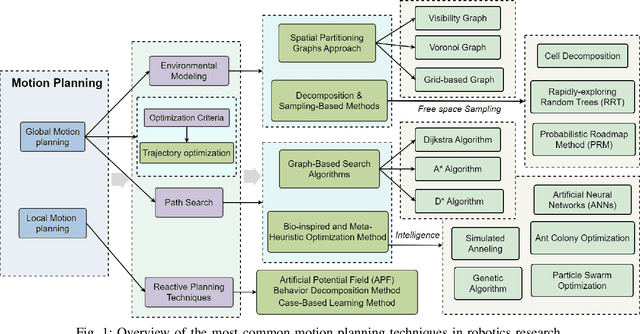
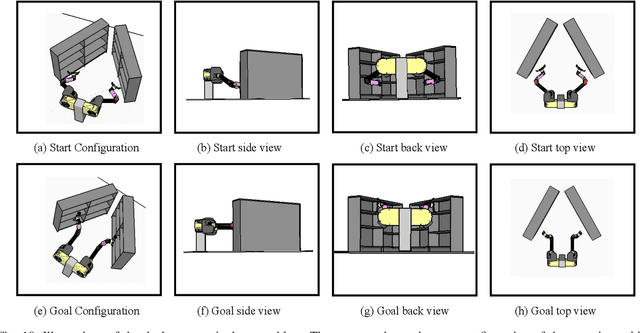
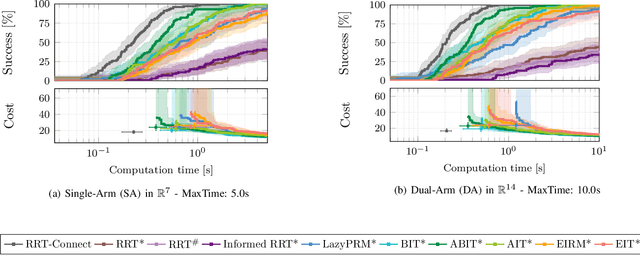
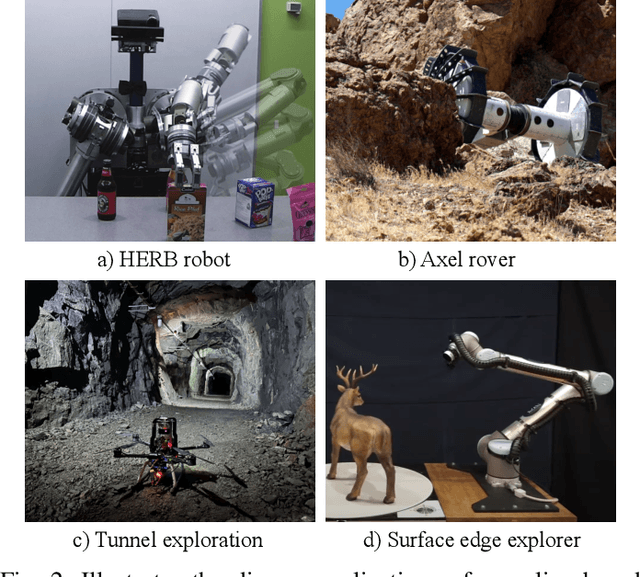
Abstract:Recent advancements in robotics have transformed industries such as manufacturing, logistics, surgery, and planetary exploration. A key challenge is developing efficient motion planning algorithms that allow robots to navigate complex environments while avoiding collisions and optimizing metrics like path length, sweep area, execution time, and energy consumption. Among the available algorithms, sampling-based methods have gained the most traction in both research and industry due to their ability to handle complex environments, explore free space, and offer probabilistic completeness along with other formal guarantees. Despite their widespread application, significant challenges still remain. To advance future planning algorithms, it is essential to review the current state-of-the-art solutions and their limitations. In this context, this work aims to shed light on these challenges and assess the development and applicability of sampling-based methods. Furthermore, we aim to provide an in-depth analysis of the design and evaluation of ten of the most popular planners across various scenarios. Our findings highlight the strides made in sampling-based methods while underscoring persistent challenges. This work offers an overview of the important ongoing research in robotic motion planning.
History-Aware Planning for Risk-free Autonomous Navigation on Unknown Uneven Terrain
Jun 04, 2024Abstract:It is challenging for the mobile robot to achieve autonomous and mapless navigation in the unknown environment with uneven terrain. In this study, we present a layered and systematic pipeline. At the local level, we maintain a tree structure that is dynamically extended with the navigation. This structure unifies the planning with the terrain identification. Besides, it contributes to explicitly identifying the hazardous areas on uneven terrain. In particular, certain nodes of the tree are consistently kept to form a sparse graph at the global level, which records the history of the exploration. A series of subgoals that can be obtained in the tree and the graph are utilized for leading the navigation. To determine a subgoal, we develop an evaluation method whose input elements can be efficiently obtained on the layered structure. We conduct both simulation and real-world experiments to evaluate the developed method and its key modules. The experimental results demonstrate the effectiveness and efficiency of our method. The robot can travel through the unknown uneven region safely and reach the target rapidly without a preconstructed map.
 Add to Chrome
Add to Chrome Add to Firefox
Add to Firefox Add to Edge
Add to Edge